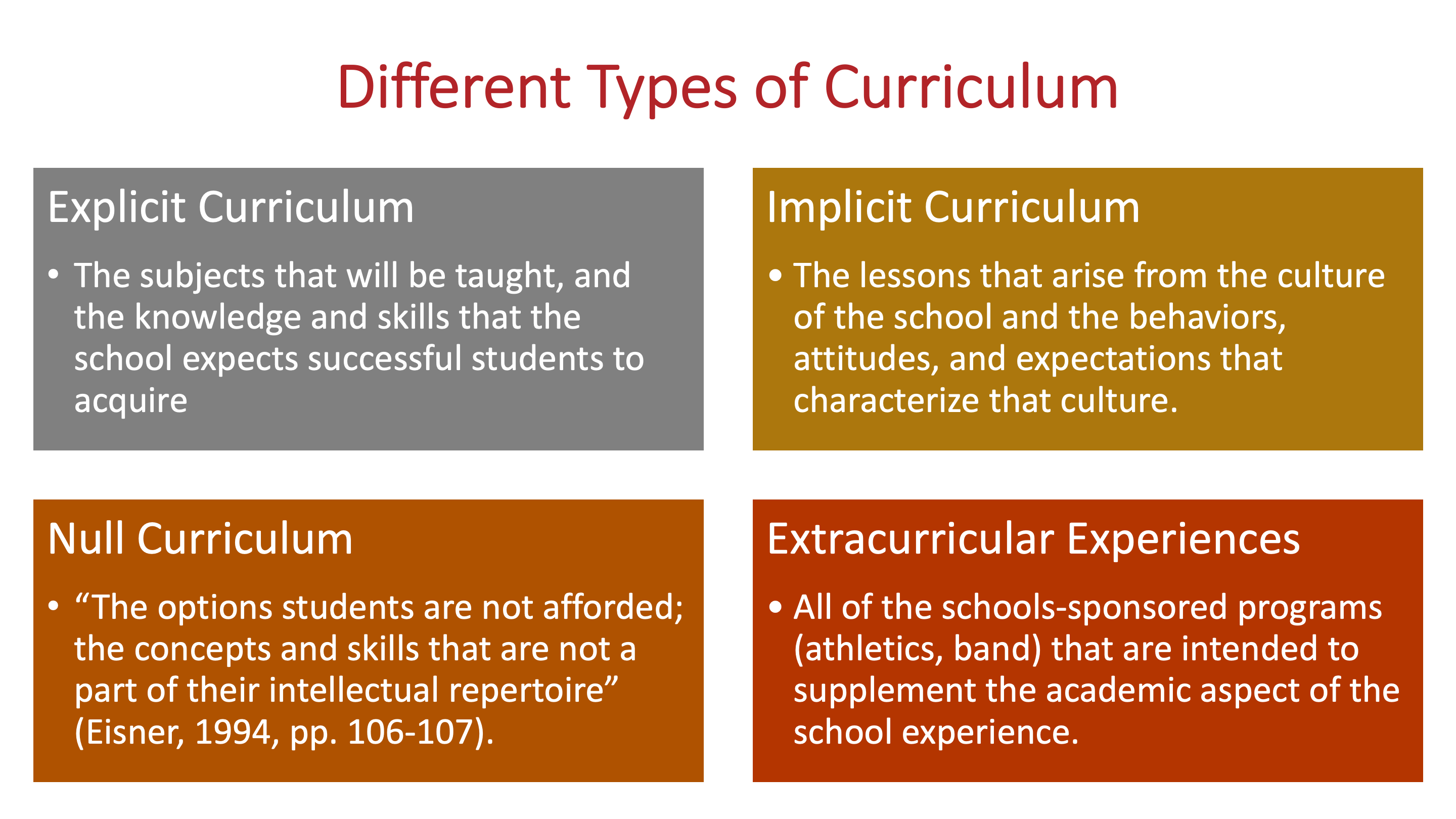5.2: Sociological Influences of the Four Curricula
- Last updated
-
-
Save as PDF
There are four different types of curricula that educators have to address in the classroom; t hese four are the explicit, implicit, null, and extracurricular. The most obvious curriculum in the classroom is the explicit curriculum because that is the curriculum that has been approved by the agency that approves public school curriculum in your state (in California, that is the California Department of Education) as well as by your school district. Curriculum of extracurricular activities also exists for such activities as academic clubs, band and chorus, or sports. The curriculum that is not so obvious is the implicit or “hidden curriculum” and the null curriculum, which is information that students may never be exposed to because they are excluded from the explicit curriculum. Each of these curricula will be explained below with examples to illustrate what each entail.

Explicit
Explicit instruction can be described as being a curriculum that has been intentionally designed, field tested by educators, and disseminated publicly, often with resources that will help teachers facilitate classroom instruction.
In California, Curriculum Frameworks guide the development of criteria. From the California Department of Education website:
Curriculum frameworks provide guidance for implementing the content standards adopted by the State Board of Education (SBE). Frameworks are developed by the Instructional Quality Commission, formerly known as the Curriculum Development and Supplemental Materials Commission, which also reviews and recommends textbooks and other instructional materials to be adopted by the SBE.
Schools in California, other states and abroad may review and use the California State Board of Education-adopted Content Standards and Curriculum Frameworks in developing their own curricula.
The following is an excerpt from the Executive Summary English Language Arts/English Language Development Framework for California Public Schools, Kindergarten-Grade 12. It gives an indication of how a curriculum framework guides instruction:
Grade Five Students approach text with greater purpose and critical stances. They voice their views in light of multiple perspectives and textual evidence. They begin to realize that they can interact with a text in ways that allow them to more deeply understand the text’s meaning and also question its premises. Students use several sources when conducting research projects. Their language and knowledge continue to expand as they engage in voluminous reading and participate in rich content instruction. They learn about the varieties of English used in stories, dramas, or poems. They also become skilled at keyboarding, typing a minimum of two pages in a single setting, and use technology and media to learn and to share their ideas. Foundational skills are used effortlessly; reinforcement is provided as necessary to ensure fluency with print.
Implicit
The hidden curriculum are lessons that emerge from the culture of the local school district school and the behaviors, attitudes, and beliefs that have defined by the district. Bruner (1960) addressed the need to cultivate an understanding of ideas by including content beyond the explicit curriculum. An example of a hidden curriculum is character education. Character education may address values that are not part of the state-approved curriculum. While character education can be found in the explicit curriculum, the nuances of the character education program may be informed by many factors present in the local school district including the school community’s cultural expectations, values, and perspectives. A character education program may also include specific curricular topics which may contain varying ideological and/or cultural messages. Teaching strategies that connect the school to the community like problem-based learning or applied learning, can also be part of the implicit curriculum.
Null
Eisner (1985) defined null curriculum as information that schools do not teach:
… the options students are not afforded, the perspectives they may never know about, much less be able to use, the concepts and skills that are not part of their intellectual repertoire (Eisner,1985, p. 107).
There are several examples of null curriculum that can be identified in content areas. For example, in social studies, the teacher may give a general overview of the history of science while covering the scientific revolution. However, this information is excluded from the formal curriculum. Another example would be the exclusion of Darwin’s theory of evolution from the official biology curriculum. Null content may represent specific facts omitted in a particular unit of study. An example of this would be a social studies unit focusing on the New Deal may not reference the fact that the New Deal failed to resolve the problem of unemployment.
Extra
Extra-curricular curriculum includes school-sponsored opportunities that fall outside of academic requirements prescribed on the local and state levels. Examples of extra-curricular activities include participation in sports, music, student governance, yearbook, school newspaper, and academic clubs. Extracurricular participation is a strategy to promote school connectedness (Centers for Disease Control and Prevention, 2009). Extracurricular activities are often associated with many positive outcomes such as higher academic achievement and decreased school dropout (Farb & Matjasko, 2012).
According to the United States National Center for Education Statistics (2012), sports are the most common type of extracurricular activity among secondary school students, with 44% of high school seniors reporting participation in some type of sport. Additionally, 21% of students participate in music activities, as well as clubs, such as academic (21%), hobby (12%), and vocational clubs (16%).
Contributors and Attributions
CC licensed content, Original
- Foundations of Education. Authored by: SUNY Oneonta Education Department. License: CC BY: Attribution
This page was edited and revised by Alice Hale (Chabot College) using the Libretexts remixing tool.



